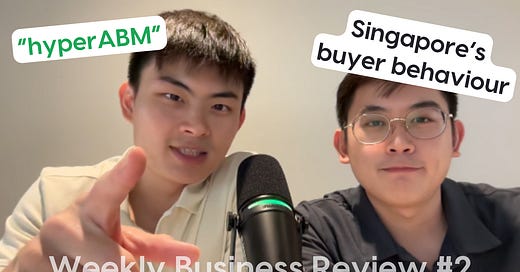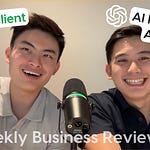We had a few interesting takeaways this week.
1. Singapore’s Buying Behaviour
We’ve been struggling to replicate the results we see overseas for our local clients.
For context, a campaign we kickstarted for a US client got a positive reply in less than 12 hours from launch.
Yet, we’re only averaging between 1-3 leads per week for our Singaporean client.
While that’s still a decent amount, the positive reply rate is less than 2%, which is not ideal.
As Justin and I were discussing, we realised the main difference is market behaviour.
Even for ourselves, we’re likely to read cold emails, but we don’t reply to them.
We would:
Visit their website
Read their blog articles
Visit their LinkedIn profile
Read their LinkedIn posts
(everything except actually replying the email)
We call it the “silent buyer”.
With this new insight, we’re tweaking our strategy to use content for nurturing and trust-building.
Here’s a quick overview:
Run educational cold email campaigns
Drive traffic to a content hub
Capture engagement metrics
Run warm outbound campaigns based on intent
Instead of relying on the email to convert, we’ll let them consume the content to build trust first.
We will update on how this new methodology works :)
2. “hyperABM” Campaigns
I argue that ABM (account-based marketing) is already hyper-personalised, but Justin argues that it’s “hyperABM” because you’re able to do it at scale.
Here’s what we mean:
Similar to the above concept of using content to build trust, when we’re driving pipeline of complex deals (think $100k+ deal sizes with multiple buying committee members), simply relying on cold emails is useless.
Nobody would fork out $100k+ from one cold email.
(if you sell high-ticket deals and you’re relying on purely cold emails to drive leads, you need to review your strategy)
So for our clients who sells to the mid-market and enterprise market, we’re splitting it up into:
Demand generation
Lead generation
Demand generation consists of:
Educational cold email campaigns
LinkedIn content posts
LinkedIn social selling
The main objective of demand generation is to drive traffic to a content hub.
From the content hub, we will have content tailored to different stages of the buying journey:
Case studies
How-to guides
Success stories
Frequently asked questions (FAQs)
We will track the engagement on the content hub, and when they reach an engagement threshold, we will run warm outbound campaigns.
This is the lead generation phase.
This way, we only reach out to warm leads who already know of us, and have some level of trust built beforehand.
3. Outbound Campaigns Are “Simple, But Not Easy”
I was having a conversation with someone and he couldn’t understand the value we bring from a lead generation perspective.
At a high level, outbound lead generation sounds simple:
Find a lead database like Apollo
Export the list
Send emails
Problem is, if it’s so simple to understand, everybody would be doing it already.
In 2025, if you want to get results from outbound campaigns, you need to be WAYYY better than everyone else.
Not just 2-5x, but 10 times better.
This includes:
Setting up proper email infrastructure to ensure deliverability
Enriching your contact info across multiple providers
Verifying your emails to ensure they don’t land in spam
Running warm outbound campaigns to prospects who know of you
A/B test messaging
Track and review performance
Constant iterations and improvements
Automating the entire process for faster speed-to-lead
Bottom-line is, it’s easy to get started, but not easy to excel at it.
Even we’re still working at getting better at it.
Still much to learn and grow 💪












Share this post